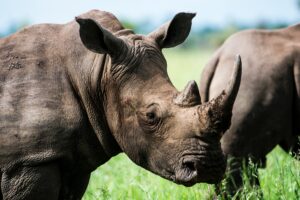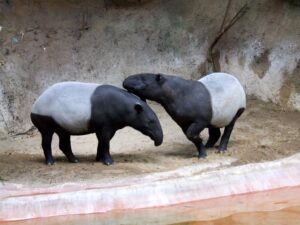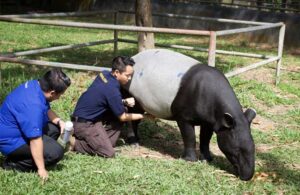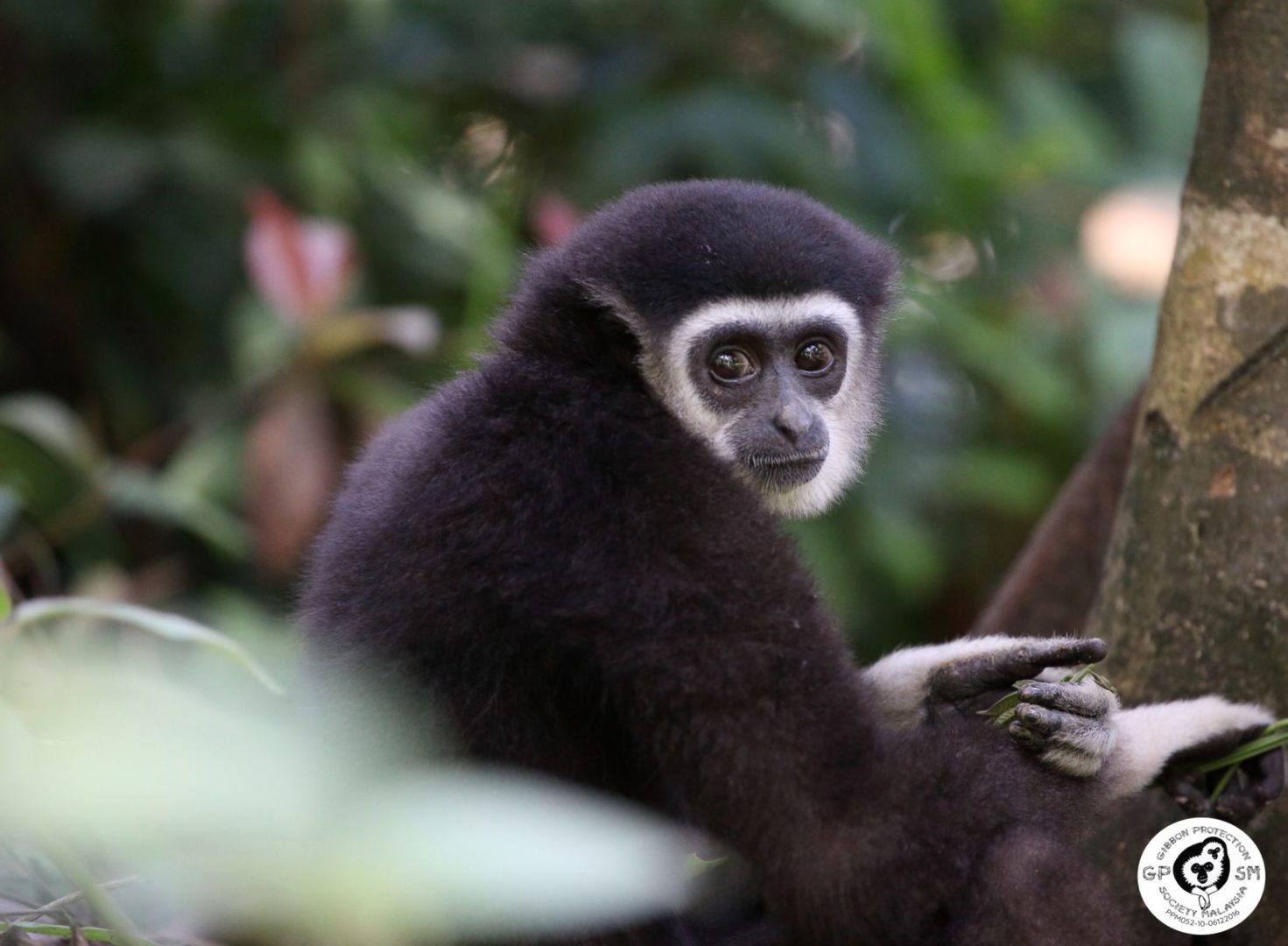In the heart of Malaysia's lush jungles, a silent struggle for survival is unfolding. The…

How can captive breeding of Malayan Tapir be effective for its conservation?
The Malayan tapir (Acrocodia Indica) is one of the big five mammals that Asia uses to promote its wildlife diversity. According to the IUCN Red List Of Threatened Species, the Malayan tapir is endangered with only 2,499 mature individuals left. Malayan tapirs are commonly found in Malaysia, Myanmar and Thailand where the climate favors their ecological needs. The Malayan Tapir is also called OREO because it resembles an OREO cookie. The front and back sides are black, the central part is gray or white, and it has a large tubular body and extended snout also called a proboscis.
A frequent victim of human-wildlife conflict

One of the biggest threats to tapirs is accidental contact with humans. A recent news article reported about a 300-kilogram female Malayan tapir caught in a trap in Negeri Sembilan’s Kenaboi Forest Reserve. According to the news, the Malayan Tapir was relocated and released back into the forest that same day. Because of their poor vision, tapirs rely on their sense of smell to navigate the forest. Possibly, it was the scent of a Machang fruit tree near the residential area that lured the tapir into the village.
The main threats to the Malayan Tapir are habitat destruction and poaching. Because their reproduction rate is much slower than other mammals, they are being wiped out faster than they can reproduce.
What is captive breeding of Malayan Tapir and its process?

Captive breeding is interpreted as the breeding of (endangered) species in captivity where the offspring is being released back into the wild to either repopulate or restore an ecological niche. Breeding programs can also provide long-term economic benefits to the local community as they provide new employment. The wide array of manpower needed opens opportunities for locals to learn about these precious animals and secure a career in Nature Conservation. The captive breeding centre could also serve as an educational opportunity for tourists, students, researchers, and the general public. A win-win situation where the economic benefits, as well as the Malayan Tapir, are being protected.
The ability to breed, raise and release enough offspring for Tapirs relies on a sound and science-based breeding and husbandry programme. Ideally, the breeding centre should also be associated with a specialist group that focuses on the preservation of Malayan tapir. For instance, the IUCN SSC Tapir Specialist Group (TSG) , a panel of conservationists and scientists dedicated to conserving Tapirs and their habitat. When the released Tapirs are able to survive, flourish, and reproduce, the breeding and conservation program can be considered a success.
Next to breeding Malayan Tapirs, it is important to invest at least as much energy and resources in conserving their natural habitats and the natural corridors connecting those habitats.
Where is captive breeding of Malayan Tapir being practised in Malaysia?

According to the Sixth National Report of the convention of Biological diversity, Malaysia’s current captive breeding programmes are divided between conservation centers and Zoos. Malaysia have reserved areas to protect its wildlife and marine biodiversity such as :
- Belum-Temengor Complex
- Endau Rompin Complex (Malayan Tiger and Malayan Sunbear)
- Taman Negara (variety of animals and plants)
- Kabili Sepilok Forest Reserve (Orang Utans)
- Sepilok Rehabilitation Centre (Orang Utan)
- Borneon Sunbear Conservation Centre (Sun bear)
For marine species (mainly giant turtles) - Cagar Hutang nesting beaches of Redang Marine Park in Terengganu
- Pulau Rusukan Besar in the Federal Territories of Labuan
- Pulau Pinang Mak Kepit
The Sungai Dusun Wildlife Conservation Centre: the captive breeding of Malayan Tapir in Penisular Malaysia
In Malaysia, the Sungai Dusun Wildlife Conservation Centre is managed by Perhilitan (Department of Wildlife and National Parks Peninsular Malaysia) and is the only rehabilitation centre for the Malayan Tapir in Penisular Malaysia. The Sungai Dusun Wildlife Reserve was established in 1964, and was first reserved to protect the Sumatran rhinos. Unfortunately, the breeding program was unsuccessful. The Sumatran Rhino went extinct in Malaysia in 2015. The Malayan tapir breeding programme was introduced into the facility in 2004.
In other countries, Tapir breeding programmes have been proven successful where the staff was provided with good working knowledge of the Tapir’s biology and behaviour. Studies confirms that often, lack of information and training are largely responsible for the physical and behavioural problems of captive tapirs. Their social behaviour in captivity largely depends on the individual animal personality, past experiences, food availability and size/layout of the enclosure.
What should be practised in the captive breeding area?
Next to breeding Tapirs, the program should also adopt methodologies that prepare the offspring for release into the wild. Malayan tapirs are timid animals who are easily disturbed by people.The caretakers should train the animal to gain skills necessary for their survival in the wild. For example, they must learn to forage and recognise food, avoid predation, attract mates, and find appropriate shelter. They must be able to utilize their sense of smell. Because their main predators are tigers, Malayan tapirs should be able to recognize their predator’s scent so they can avoid entering dangerous territories. Finding food i.e. foraging is another important skill. According to a study by Geetha Anavi,to train the Malayan Tapirs in finding food, the leaves or fruits should be scattered around in the enclosure to stimulate them to forage on their own.
Tapirs need indoor as well as outdoor enclosures, with access to shade at all times, and should be designed so that adult animals can be easily separated and introduced. It is preferred for each animal to have its own indoor stall connected to a common outdoor exhibit.
Tapirs are herbivores, and with a digestive system similar to that of a horse, need to eat small meals throughout their active period. They become sexually mature before 2 years of age. Their gestation period is approximately 13 months, which produces one calf. The breeding behaviour varies between individuals and depends on age, experience, and compatibility of the pair. Some tapirs prefer to mate in shallow water, while some others on dry land. Another important reason for having appropriate enclosures that allow enough space and choice of different substrate, including a pool.Tapir calves are weaned off by 4 months of age, and acquire the same oreo-like mantel colours like the adults by 6 months of age. Like all captive animals, also Tapirs are susceptible to medical problems. However, prevention is possible with appropriate and consistent husbandry methods and regular veterinary check-ups.
As soon as the offspring is ready to be released, it is important to determine a suitable release site. Importantly, the site should be highly protected so that the efforts made in captive breeding can be monitored. The wild area should be free from human disturbance, such as poachers. Post-release monitoring in tandem with a surveillance team should be implemented to avoid human interference and illegal poaching in the area, and to study the effects of the breeding program.
A need for support and professional development within Wildlife rehabilitation
Wildlife rehabilitators play a major role in captive breeding and rehabilitation programmes . They prepare the captive animals for release into the wild.The current results and effects of the Malayan tapir breeding program in Penisular Malaysia are unclear. Perhaps the Malaysian wildlife services are in need of professional support to increase their capacity and knowledge to develop a successful conservation program?
Like any other profession, Wildlife rehabilitators need a consistent professional development program. In this way, they keep up with new findings about wildlife and their ecological needs so that these can be reproduced in captivity to increase their chance for survival. Also, in the veterinary field wildlife medicine is quickly developing, and therefore frequent training for the veterinarians is necessary to guarantee the best healthcare to the animals in captivity .
Rehabilitators should regularly take the opportunity to share their knowledge with the community, in particular with those that live in proximity of wild Tapir territories. It is important to educate the community about these precious species and the important role they play in preserving Malaysia’s biodiversity. Rangers should also advise and instruct how to react in case there is an encounter with a wild tapir. People should not panic nor hurt the Malayan Tapir, but inform Perhilitan so they can relocate the animal safely. A common basic understanding about these animals and how to react in case of encounter could save the lives of countless Malayan tapirs, victims of traffic accidents, and hunting.
Conclusion
 A successful captive breeding project involves the government, non-governmental organizations, and the public in general to provide a holistic conservation approach. New studies on the current conservation state of the Malayan Tapir in Penisula Malaysia are needed to identify an effective approach to the conservation of this iconic species. As for suggestions, Perhilitan could closely collaborate with Malayan Tapir experts, enthusiastic and professional non-profit organizations, to establish a conservation action plan for the Malayan tapir in Peninsular Malaysia.
A successful captive breeding project involves the government, non-governmental organizations, and the public in general to provide a holistic conservation approach. New studies on the current conservation state of the Malayan Tapir in Penisula Malaysia are needed to identify an effective approach to the conservation of this iconic species. As for suggestions, Perhilitan could closely collaborate with Malayan Tapir experts, enthusiastic and professional non-profit organizations, to establish a conservation action plan for the Malayan tapir in Peninsular Malaysia.
Given the unclear results of past efforts with the Malayan tapir breeding program, it would be advisable to review the current infrastructure and staff training. Crucially, this should comply with international standards of Tapir breeding, husbandry and rehabilitation programs
Moreover, understanding the infrastructural and operational needs of a breeding program will justify the seemingly high budget and staff expenses. For example, the San Diego Zoo conducts an effective captive breeding program of Tapir species. They started successfully with a male and female Malayan Tapir in 1940 and to date, there are 31 Malayan tapirs born at San Diego Zoo and San Diego safari. Their high consideration and investment on the Tapirs led the successful captive breeding program. Captive breeding has the potential to transform the Malayan Tapir’s future, but only if we focus and collaborate as a team.
ARE YOU LOOKING FOR A JOB IN CONSERVATION?





